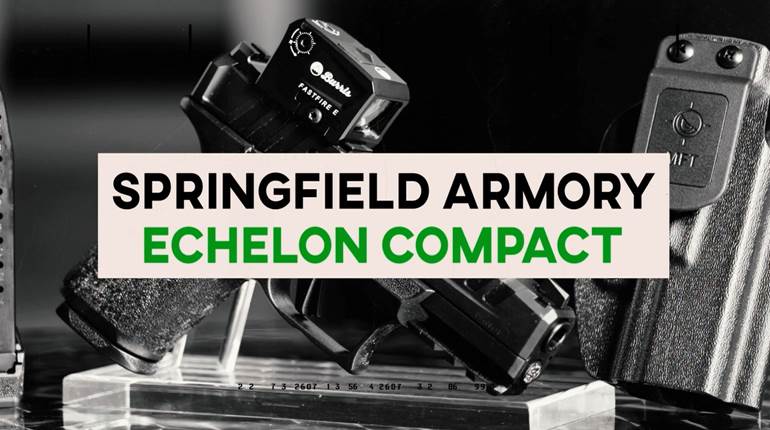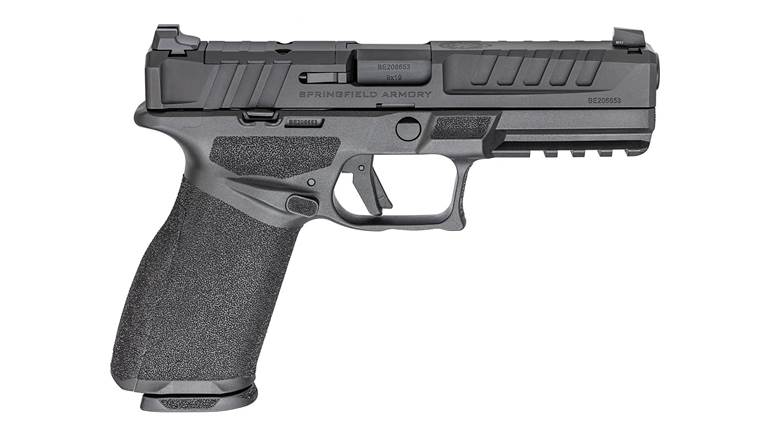
This feature article, “The XD Goes Full Bore,” appeared originally in the April 2006 issue of American Rifleman. To subscribe to the magazine, visit the NRA membership page and select American Rifleman as your member magazine.
Since the mid-1980s, the standard in duty pistols has been a high-capacity semi-automatic with a polymer frame and some form of constant-action trigger system. Throughout the past two decades of aggressive development and hard use—particularly in the American law-enforcement community—this kind of handgun has evolved as a distinct pistol type. Glock pistols set the pace and remain immensely popular. But newer models have been brought to market by a host of companies, and some of them are doing quite well.
One of the very best polymer pistols available today is Springfield’s XD—a Croatian-produced, military-inspired duty gun that was initially chambered in 9 mm, .40 S&W, .357 Sig and later .45 GAP. While the XD offered a broad choice of chamberings and the GAP-chambered .45s sold respectably well, many shooters held out hope for an XD in .45 ACP. As most shooters know, the .45 GAP cartridge has nearly identical performance as the .45 ACP. Still, .45 GAP guns and ammo simply did not catch fire.

Since 9 mm, .40 S&W, .357 Sig and .45 GAP cartridges are virtually the same length, it was not difficult to modify the XD’s magazine dimensions and feed ramp contours to make the same basic frame work for all of them. However, the .45 ACP cartridge is significantly longer. Making it feed and function requires some major changes to the basic XD frame.
Before we get into those, let’s examine the XD pistol in general. It follows the modern pattern for a duty auto with a molded polymer receiver and steel slide. Also, it is a recoil-operated gun, working on the basic Browning principle of a barrel cammed upward into a locked relationship with the slide as it goes into battery. XD magazines are of the staggered-column type, with capacities consistent with the various calibers.

The XD lockwork has a unique trigger, which the company calls the USA (Ultra Safety Assurance) system. In this design, trigger pressure disengages two safeties in the action. There is also a grip safety that is a spring-loaded lever mounted in the backstrap. When depressed by a shooter’s hand in a strong shooting grasp, the grip safety’s internal surfaces clear the pistol’s striker mechanism and allow it to move. The USA system used in all of the XDs feels like many of today’s DAO triggers, but it is really different. It is like them only in the sense that it is constant. In other words, the trigger acts the same for every shot. It is extraordinarily easy to manage, since there are no intermediate levers to manipulate. Just grasp the pistol, align the sights, and squeeze the trigger.
A good bit of the XD’s popularity stems from the fact that the gun is shaped in a way that appeals to a great many shooters. The butt section is at a proper angle for aimed fire, and there is a deep pocket for the web of the hand. It is high enough that the bore axis is low in the hand. There are other good features such as the dished-out thumbrests on each side of the butt, the checkering molded into both the frontstraps and the backstraps, and a loaded-chamber indicator you can see and feel in the back edge of the ejection port. XDs are nearly ambidextrous, particularly in that the magazine catch pushes in from either side to release the drop-free magazine.

The .45 ACP magazine is both taller and deeper from front to back. Except for the longer grip section, there is little change in the dimensions of the newer and larger XD .45 pistol. That’s because Springfield’s designers found a way to use a larger magazine in nearly the same size frame. Here’s how they did it. The sidewalls of the XD .45 ACP magazine well are substantially thinner than those of the .45 GAP, by approximately 0.077". The backstrap on the butt is shallower by 0.100". They were able to manage this by changing the curve of the backstrap and taking advantage of the unused space in the original design. As a subjective matter, most shooters won’t even notice the difference in the grip of the .45 ACP XD. But when you get to work with ruler, caliper and tape, it becomes a little more obvious that Springfield went to considerable effort to craft the industry’s newest high-capacity .45 ACP pistol.

Of all the high-capacity .45 ACP pistols I have ever handled, the XD strikes me as the most ergonomically sound. This is an easy pistol to manage in the combat-style shooting exercises for which it was developed.
For the purposes of this evaluation, I had access to two specimens of the XD pistol in .45 ACP. They shared the same type of black polymer receiver, but differed in the length of their barrels and slides as well as the construction. The longer-barreled XD had a stainless steel slide, housing a 5" barrel. The other gun’s slide was carbon steel with a black Melonite coating housing a 4" barrel. There was also another option of .45 XDs finished in the increasingly popular NATO green color.
There are some things that make the XD pistols easy to use. A loaded-chamber indicator is on top of the gun and may be checked visually or by feel. The status of the striker can as well, since the rearmost tip protrudes from the rear center of the slide.

I fired each of the two pistols shown in this story in both accuracy evaluations from the bench and in a few tactical drills. In doing so, I found that the trigger action and the recoil properties of the shorter gun were much to my liking. This is not to say that the longer gun was deficient in any way, it’s just that the 4" XD seemed a bit easier for me to handle. The accuracy of the two guns was on a par with most modern guns, and you can see just how they performed in the adjacent tables.
Springfield Armory always seems to have its corporate finger on the pulse of the American shooter, and the new XD in .45 ACP is proof of that.




































